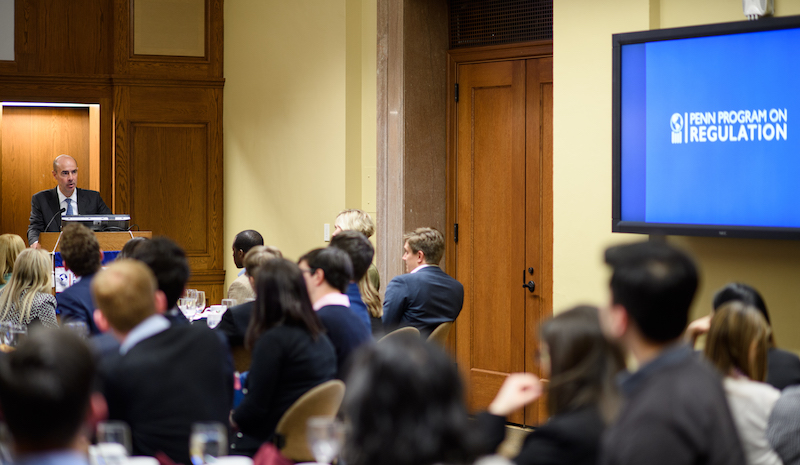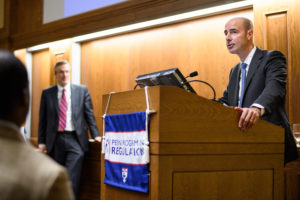
Scalia recounts his role in challenging a SEC rule on behalf of the U.S. Chamber of Commerce.
When I looked at the record compiled by the agency in the first rulemaking by the U.S. Securities and Exchange Commission (SEC) I was involved in, I was struck by the almost complete absence of economic analysis. As an employment lawyer I had seen cost-benefit analyses by the Occupational Safety and Health Administration and the Wage and Hour Division of the Labor Department; I was familiar with the lively debate over the role of cost-benefit analysis in environmental regulation. The SEC was regulating the financial markets—direct economic regulation. I therefore expected the Commission to be particularly attentive to economic impacts, and particularly adept at assessing them.
Far from it. This particular SEC rulemaking concerned the extent to which directors of mutual funds should be required to be independent of the advisory firm that manages the fund. It was a hotly disputed rule, yet there had been just one economic study submitted for the rulemaking record.

Gene Scalia takes questions from students following his lecture.
But even that was too much for the Republican-appointed Chairman of the SEC. The SEC holds public meetings when it adopts rules, and in the meeting to adopt the new mutual fund governance rule, the SEC Chairman said he was not going to await further economic analysis before adopting the rule, because, he explained, “there are no empirical studies that are worth much. You can do anything you want with numbers.” This was seconded by another of the commissioners, who—in voting for the rule—said the Commission should not await economic studies because “methodologies will always be flawed or at least subject to question.”
Now this would be extraordinary for virtually any agency. But this was a financial regulatory agency, whose business is economic impacts—not protecting health or safety, but regulating economic relationships. When you regulate the economy, you ought to find some room for economic analysis in your analysis of regulations’ effects. Moreover, the SEC in this rulemaking had a duty, under the governing statute, to consider the effects of its new rule on “efficiency, competition, and capital formation.”
I ended up challenging this particular SEC rule on behalf of the U.S. Chamber of Commerce, and since then have handled a series of cases challenging SEC regulations. In a number of these cases, my clients challenged the rule based in part on deficiencies in the agency’s cost-benefit analysis.
A small academic literature has grown up around these D.C. Circuit cases; much of it has been very critical of the court’s rulings. A number of academics have concluded that the D.C. Circuit has demanded too much of financial regulatory agencies, and some have suggested that requiring cost-benefit analysis of financial rules is too tall an order. (There are also respected academics who disagree.)
I do not agree with the critics of these decisions, in part because I am very familiar with the evidence that was before the agency in the cases, and with what the agency did and did not do with the evidence before it. The SEC mutual fund governance rule is a case in point. The court’s analysis in that case has been criticized as too demanding. But recall what the Chairman of the SEC said: “There are no empirical studies that are worth much. You can do anything you want with numbers.” And recall his colleague’s assertion that the Commission should not wait for economic evidence because “methodologies will always be flawed or at least subject to question.” While there certainly are limits to the economic analysis that can be performed on a rule, the SEC 10 years ago was not pushing those limits—it was not trying to engage in a genuine analysis of the economic effects of its rules at all.
Another decision that has come in for a lot of criticism is the D.C. Circuit’s invalidation of the SEC’s so-called proxy access rule. This rule permitted certain large shareholders to use the company’s proxy to put forward their own alternative candidates for the board of directors. The idea was that by enabling dissident shareholders to put forward alternative director candidates without the expense of a full-blown proxy contest, the rule would make it easier to field candidates for director positions; this, in turn, would broaden the pool of candidates and make directors more vulnerable to challenge and more responsive to shareholders, thereby improving the caliber and performance of directors and ultimately the company as a whole.
As in the mutual fund case, the D.C. Circuit invalidated the rule as arbitrary and capricious and for falling short of the SEC’s duty to consider economic effects. The decision has been criticized for setting too high a bar for the SEC.
In truth, the SEC made a number of elementary mistakes in this rulemaking. In partial response to some of this academic commentary, I will mention two.
First, the SEC never had a coherent theory of how prevalent the new proxy access mechanism in the rule would become—how frequently it would be used. The basic concept was that contesting director elections would be much easier and therefore more frequent, with the end result that there would be more candidates to choose from, and directors would be better and more responsive. How often this mechanism would be used was therefore directly related to how effective it would be—but at the same time, the frequency with which it was used was closely tied to the direct costs it would impose.
In estimating these costs in the preamble to the final rule, the SEC lowballed how frequently the access mechanism would be used: The mechanism would be deployed in 51 corporate board elections a year, the Commission projected. This meant it would be used less frequently than traditional proxy contests, even though the premise was that proxy access would be easier—more accessible—than traditional proxy contests.

Penn Law Prof. Ryan Doerfler visits with students.
But later in the preamble, when estimating the rule’s benefits, the SEC said that the new mechanism would save about $18,000 each election compared to the cost of a traditional proxy contest, and added this: Although $18,000 in cost savings may not seem like a lot, the rulemaking comments “regarding the likely increase in the number of election contests resulting from the new rules . . . strongly indicate that the benefits” would far exceed that $18,000 figure. The Commission then cited rulemaking comments to support these claimed benefits—and the comments it relied on projected a far more frequent use of the access mechanism than the 51 contests the SEC had predicted when estimating the rule’s costs. As the D.C. Circuit concluded, the SEC had acted “opportunistically” in assessing costs and benefits: “The Commission anticipated frequent use of [the rule] when estimating benefits, but assumed infrequent use when estimating costs.” This was bad cost-benefit analysis, and it was arbitrary and capricious.
One lapse by the SEC in this rulemaking, then, was not having a coherent view of how frequently this new mechanism would be used. A second lapse lay in not considering who would use it. Under the SEC’s rule, only certain of a company’s largest shareholders would be eligible to use the proxy access mechanism: those that held at least 3 percent of the shares outstanding for three years or more. A significant number of these shareholders would be union pension funds established in collective bargaining with employers, and the pension funds of states and locales, such as the CalPERS fund.
These pension funds were among the most vocal proponents of the access mechanism in the rulemaking, yet their interests can be quite different than a typical shareholder’s. Commenters cited evidence that labor unions use pension funds’ investments in public companies as a means of pressuring companies to make certain business decisions, such as recognizing a labor union as the bargaining representative of workers at a particular facility. Similarly, some commenters argued that government pension funds sometimes are motivated by political objectives that bear little relationship to maximizing the value of their investment in a company.
Commenters argued that these specialized interests undermined a central premise of the rule—that the large, long-term shareholders using the access mechanism would act in a manner that was likely to reflect the interests of shareholders as a whole.
In the rulemaking, the SEC ignored this criticism of its proxy access proposal. It did not even use the word “union” in its lengthy release adopting the rule (except when citing comments by the many labor unions that supported the rule). This became a key argument for the challengers in the court of appeals: Significant evidence had been presented that the rule would be used differently than the SEC intended, yet the SEC had ignored that evidence. This failure of the SEC to respond to record evidence was a garden-variety failure under the Administrative Procedure Act, and it was a serious deficiency in the Commission’s assessment of the rule’s benefits. The court was right to invalidate the rule in part on this ground, and it was right to vacate the rule as a whole: When an agency does not have a clear view of who will use its rule, for what purpose, and how often, there has been a serious lapse in reasoned decision-making.
This essay is the second of a three-part series, The Public’s Role in Administrative Law, drawing on Scalia’s keynote address at the 2017 Annual Penn Program on Regulation Lecture.




